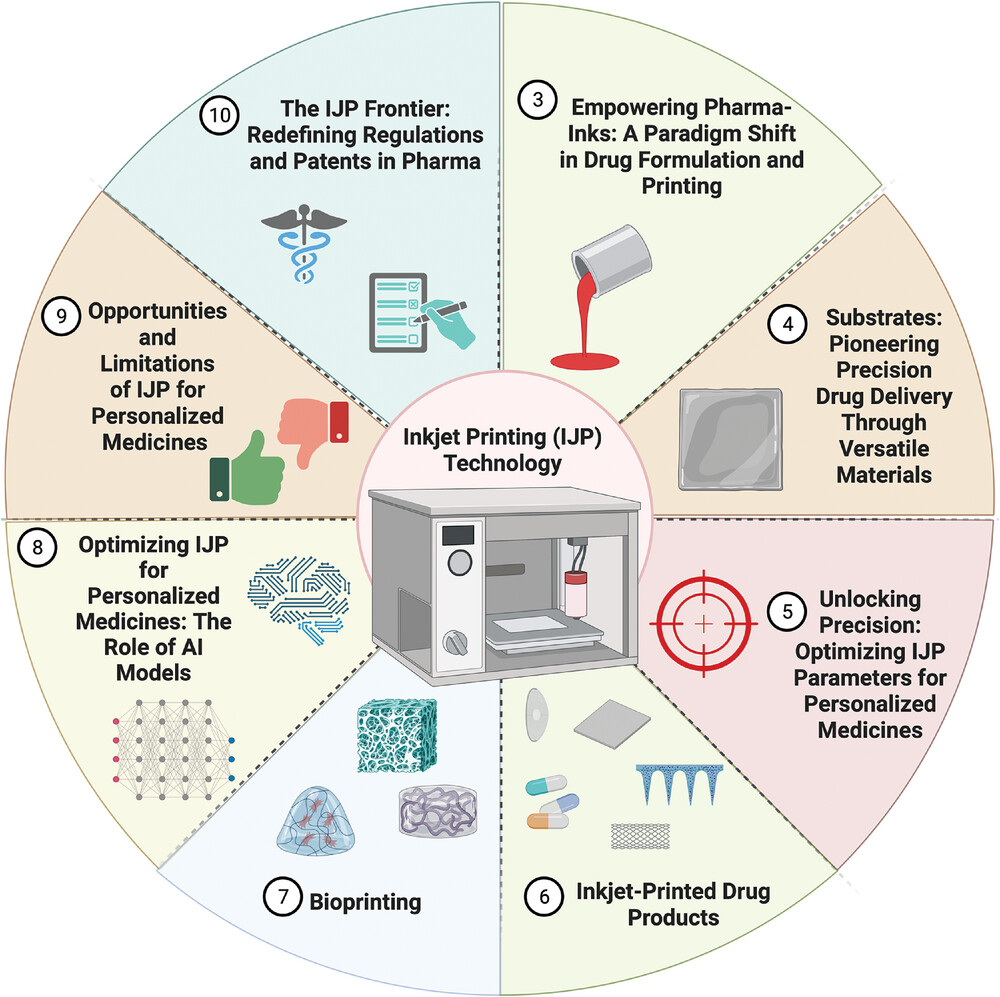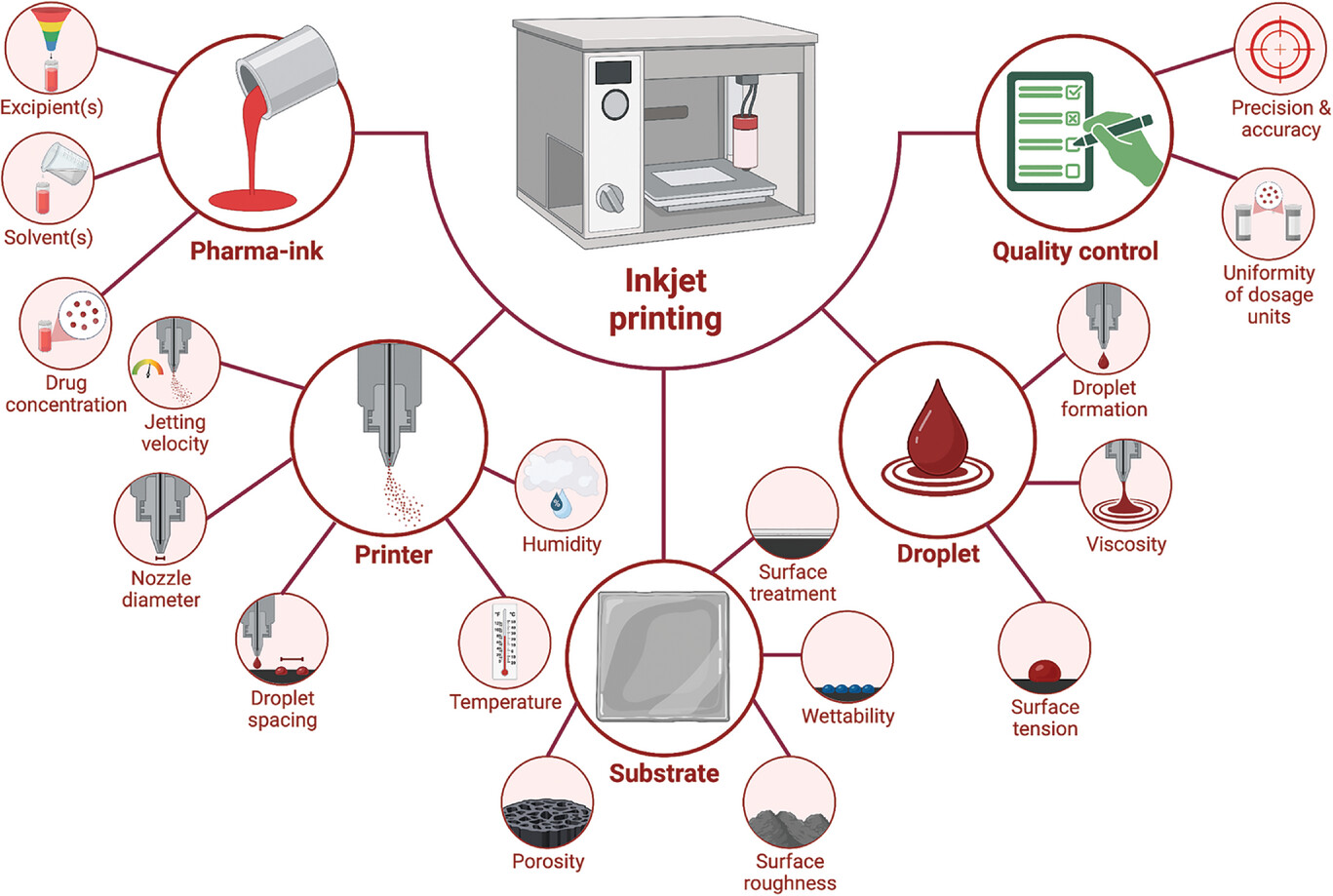| Apr 13, 2024 | |
Pharmaceuticals from the inkjet printer |
|
| (Nanowerk Spotlight) In pharmaceutical manufacturing, the drive towards personalized medicine has consistently faced obstacles posed by traditional production techniques. Standard methods, which typically involve mass production of medications in large batches with fixed dosages, fail to meet the diverse health requirements of individual patients. | |
| This conventional approach often results in less-than-optimal therapeutic results, evidenced by data indicating that a substantial percentage—up to 70%—of medications do not achieve their intended effectiveness. Furthermore, this lack of customization contributes significantly to the prevalence of adverse drug reactions, a common cause of hospital admissions. | |
| Over the years, researchers have sought alternative technologies to overcome these challenges and pave the way for precision medicine. Additive manufacturing, commonly known as 3D printing, has emerged as a promising avenue for creating customized pharmaceutical products. | |
| However, early attempts faced several hurdles, including the inability to precisely control drug dosages, limited material compatibility, and the potential degradation of heat-sensitive active pharmaceutical ingredients (APIs) during the printing process. | |
| Recent advancements in adjacent fields, such as material science and nanotechnology, have opened new possibilities for tackling these persistent obstacles. The development of novel biocompatible and biodegradable polymers, along with the ability to manipulate materials at the nanoscale, has provided a foundation for more sophisticated and adaptable drug delivery systems. | |
| Moreover, the integration of digital technologies, such as computer-aided design and modeling, has enabled the creation of complex geometric structures and precise control over drug release profiles. | |
| Against this backdrop, a transformative technology has emerged as a potential game-changer in the pursuit of personalized medicine: inkjet printing (IJP). A comprehensive review published in the journal Advanced Materials ("Inkjet Printing of Pharmaceuticals") delves into the immense potential of IJP in revolutionizing pharmaceutical manufacturing and drug delivery. | |
 |
|
| Summary of the scope of the different sections of review. (Image: reprinted from DOI: 10.1002/adma.202309164, CC BY) | |
| Unlike traditional 3D printing techniques, IJP offers highly precise and flexible deposition of pharmaceutical formulations. By harnessing the power of meticulously formulated pharma-inks containing drugs and excipients, IJP enables the selective deposition of materials, layer by layer, to create customized dosage forms tailored to individual patient needs. | |
| This technology not only allows for accurate control over drug dosages but also facilitates the incorporation of multiple APIs within a single dosage form, opening up new possibilities for combination therapies and patient-centric treatments. | |
| The versatility of IJP extends beyond the formulation of pharma-inks. The technology is compatible with a wide array of substrates, including paper, films, foams, contact lenses, and even 3D-printed materials. This substrate adaptability enables the development of novel drug delivery platforms, such as orodispersible films, mucoadhesive buccal films, and drug-loaded medical devices like microneedles and stents. By leveraging the unique properties of these substrates, IJP can enhance drug solubility, bioavailability, and targeted delivery to specific sites within the body. | |
| One of the most promising applications of IJP lies in the realm of data-enriched edible pharmaceuticals (DEEPs). These innovative dosage forms not only contain the required medication but also encode vital information such as patient details, dosing instructions, and batch numbers in the form of QR codes or data matrices printed directly onto the dosage form. This integration of digital information with the physical drug product enables real-time tracking, prevents counterfeiting, and facilitates patient adherence to treatment regimens. | |
| The potential of IJP extends beyond oral and transdermal drug delivery. Researchers have successfully employed this technology for ocular drug delivery using drug-loaded contact lenses, as well as for the development of drug-eluting stents for cardiovascular applications. Moreover, IJP has shown promise in the field of bioprinting, enabling the precise placement of cells, biomaterials, and biomolecules to create complex tissue constructs and advance regenerative medicine. | |
 |
|
| Summary of the critical processing parameters involved in the pharmaceuticals inkjet printing process. (Image: reprinted from DOI: 10.1002/adma.202309164, CC BY) | |
| As with any emerging technology, IJP faces certain challenges that need to be addressed before widespread adoption in the pharmaceutical industry. The development of suitable pharma-inks with optimal rheological properties and printability remains a critical aspect. | |
| Additionally, the current lack of pharmaceutical-grade hardware solutions specifically designed for IJP limits its scalability and compliance with regulatory standards. However, ongoing research efforts and collaborations between academia and industry are actively working to address these challenges. | |
| The integration of artificial intelligence (AI) and machine learning (ML) algorithms is another exciting avenue that holds significant promise for optimizing IJP processes. By leveraging vast datasets and advanced predictive models, researchers can accelerate the development of pharma-inks, predict printability outcomes, and streamline the overall manufacturing workflow. | |
| These AI-driven approaches have the potential to substantially reduce the time and cost associated with formulation development, bringing personalized medicines closer to reality. | |
| As the pharmaceutical industry embraces the era of precision medicine, IJP stands at the forefront of this transformative journey. With its high precision, flexibility, and compatibility with a wide range of substrates and APIs, IJP is poised to reshape the landscape of drug formulation and delivery. By enabling the creation of patient-specific dosage forms, enhancing drug bioavailability, and facilitating targeted delivery, IJP has the potential to improve treatment outcomes, minimize adverse reactions, and revolutionize the way we approach healthcare. | |
| While regulatory frameworks and quality control measures need to evolve in tandem with this innovative technology, the future of personalized medicine looks promising. As researchers continue to push the boundaries of IJP, collaborating across disciplines and leveraging advancements in materials science, nanotechnology, and AI, we move closer to a new era of precision pharmaceuticals tailored to the unique needs of each individual patient. | |
 By
Michael
Berger
– Michael is author of three books by the Royal Society of Chemistry:
Nano-Society: Pushing the Boundaries of Technology,
Nanotechnology: The Future is Tiny, and
Nanoengineering: The Skills and Tools Making Technology Invisible
Copyright ©
Nanowerk LLC
By
Michael
Berger
– Michael is author of three books by the Royal Society of Chemistry:
Nano-Society: Pushing the Boundaries of Technology,
Nanotechnology: The Future is Tiny, and
Nanoengineering: The Skills and Tools Making Technology Invisible
Copyright ©
Nanowerk LLC
|
|
|
Become a Spotlight guest author! Join our large and growing group of guest contributors. Have you just published a scientific paper or have other exciting developments to share with the nanotechnology community? Here is how to publish on nanowerk.com. |
|
